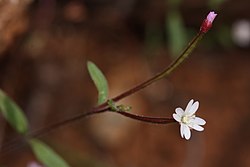| Epilobium minutum | |
|---|---|
 | |
| Epilobium minutum flower | |
| Scientific classification | |
| Kingdom: | Plantae |
| Clade: | Tracheophytes |
| Clade: | Angiosperms |
| Clade: | Eudicots |
| Clade: | Rosids |
| Order: | Myrtales |
| Family: | Onagraceae |
| Genus: | Epilobium |
| Species: | E. minutum |
| Binomial name | |
| Epilobium minutum | |
| Synonyms [1] | |
| |
Epilobium minutum is a species of flowering plant, known by the common names little willowherb, chaparral willowherb and desert willowherb, in the family Onagraceae . [1] [2] [3] It is also called "smallflower willowherb" in reference to its relatively small size. However that name, in particular the British English variant "small-flowered willowherb", typically refers to Epilobium parviflorum .
Contents

This annual wildflower is native to western North America from British Columbia and Alberta to California and Arizona. This is a plant of fields and meadows, including vernal pools, and it is one of the first flowers to spring up in areas recently cleared by wildfire.